Part 144: Protector
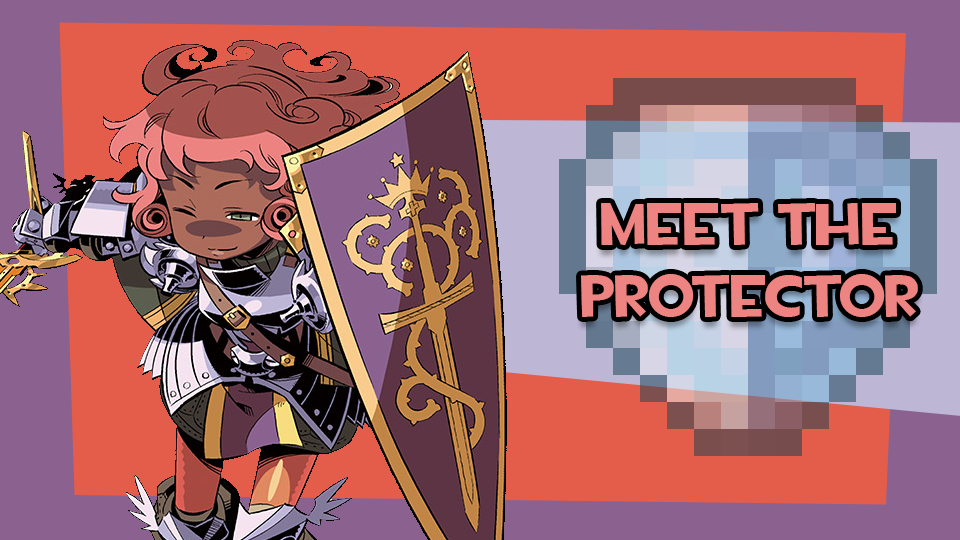

Protectors are a class almost entirely dedicated to reducing the amount of damage the party takes. While their heavily-armored designs might scream "tank," Protectors don't actually do that--Provoke allows them to try and tank, yeah, but it's not entirely reliable and falls off vs. certain enemies.
In terms of history, Protectors have changed slightly from game to game, but the core design behind them (damage reduction) is pretty much always the same. In EO1, Protectors...certainly existed. The class and most of its skills weren't really that notable due to how most of their skills worked--aside from Defender. Defender, in combination with the Medic's Immunize, could pretty much completely shatter any semblanace of difficulty in EO1. What both Defender and Immunize did was set each party member's resistance to certain elements. While Immunize affected every "element," including physical types, Defender only affected physical types, and provided a lesser bonus than Immunize. Still, having the ability to just give the entire party some flat resistance to physical damage was incredibly useful.
Moving onto EO2, Protectors got some really strange reworks--namely, several Protector skills got reworked to factor in RNG--skills like the elemental Walls and Front/Rear Guard now had chances to fail before reaching certain levels. Defender also pretty obviously got scrapped, and replaced with All Guard, a profoundly useless skill since it would never be completely reliable even at max level. The idea of Protector skills being RNG-dependent never showed up again in the series.
Even though Protectors technically didn't exist in EO3, Hoplites were basically massively buffed Protectors--the buffs being a combination of direct ones (the addition of the Parry passives and Bodyguard), and indirect ones (Ninja subclass allowing for dodge-tanking, along with Bunshin letting you have two Hoplites at once, enemies having a lot more elementals overall). That last one deserves particular mention, since the elemental Walls (known as Anti skills from EO1-3) suddenly became incredibly broken once enemies having hard-hitting elemental skills was no longer a thing mostly reserved for postgame bosses.
On the surface, Fortresses from EO4 look a lot like Protectors and Hoplites. However, the actual truth of the matter is far different. Fortresses do not offer direct damage reduction like Protectors and Hoplites did--this is most visible through the loss of Front/Rear Guard and the elemental Walls. Fortresses in EO4 are a lot more akin to Beasts, in that their job is to tank damage headed towards party members.
Now, we jump kinda back in time but also forward in time to EOU. Protectors returned with a tweaked version of their EO1/2 skillset, along with some pretty major changes. The first is a massive nerf to the elemental Walls in response to EO3--the Walls only proc once per character on a given turn. The second was the addition of Bravery's Gift, ostensibly inspired by Fortresses. What Bravery's Gift did was that it raised the user's maximum HP for one turn, and redirected all damage towards the party to the user.
Lastly, EO2U. Bravery's Gift is just straight-up gone, since it kind of intruded on the Beast's job as a class. The elemental Walls also still retain the "once per character per turn" nerf from EOU. In terms of indirect changes, Protectors got, arguably, massively buffed through the fact that a lot of bosses now have skills seemingly designed with the idea that the player will have a Protector in the party (I blame Story mode). While you can easily get through most of the game without a Protector, quite a lot of bosses will be a lot more annoying without one, and certain postgame bosses range from "incredibly difficult" to "near-impossible" without one.
Stats:
Level 1
HP: 40
TP: 31
STR: 7
TEC: 6
VIT: 10
AGI: 5
LUC: 7
Level 50
HP: 257
TP: 261
STR: 31
TEC: 29
VIT: 39
AGI: 17
LUC: 27
Level 99
HP: 575
TP: 492
STR: 58
TEC: 55
VIT: 74
AGI: 32
LUC: 51
Innate weapon choices:
 Swords,
Swords,  Axes,
Axes,  Spears (if the Highlander DLC is installed)
Spears (if the Highlander DLC is installed)Innate armor choices:
 Heavy armor,
Heavy armor,  Light armor,
Light armor,  Shields
ShieldsCommon passives: HP Up, TP Up, Phys DEF Up, Elem DEF Up, Mine
Protectors, pretty unsurprisingly, have the highest VIT out of any class in EO2U. Their HP stat's also the second-highest out of any class, beating out Landsknechts while being beaten by Beasts. Their STR and TEC stats are best described as "middling"--the TEC part's actually kind of important, since TEC is factored into how much damage a character takes from TEC-based skills. Their LUC is also similarly "middling," meaning they're not as resistant to disables as classes like Hexers and War Magi, but they're not as susceptible to being tagged with disables as classes like Landsknechts and Ronin. As you might expect out of a heavily-armored class, their AGI is absolutely terrible--at level 99, they just have 2 more AGI than War Magi, who have the worst AGI in the game.
Shield Mastery
Type: Passive
Requirements: None

Required to learn shield skills. Passively gives the user a chance to nullify physical attacks directed at them.
A decent passive that'll help your Protector survive a little longer in fights, but it's not crucial to their job since they don't really do tanking.
Front/Rear Guard
Type: Guard skill
Max level (innate): 10
Requirements: Shield Mastery level 1
Required equipment: Shield
Body parts used: Arms

Reduces all physical damage to the front/back line for one turn.
For all intents and purposes, Front Guard is a Protector's bread-and-butter skill, and one that should be leveled up early and maxed out as soon as the TP cost is sustainable. Chances are good that if a Protector isn't using an elemental Wall or Sentinel Guard, they're using Front Guard. Cutting physical damage to your front row by 55%/70% is amazingly good. Rear Guard is pretty thoroughly bad, though, since the back row already gets a 50% reduction to melee damage, and they're not often the ones at risk of dying to all-target skills.
Keep Guard
Type: Guard skill
Max level (innate): 10
Requirements: Front Guard and Rear Guard level 3
Required equipment: Shield
Body parts used: Arms

Reduces all physical damage to one party member for two turns. The user becomes unable to use shield skills for one turn.
To be entirely honest, I don't know why this skill exists. I guess if you're using a Beast, Keep Guard has some use. At that point, though, the question becomes why the fuck are you stacking a Protector and Beast in the same party?
Fire/Ice/Volt Wall
Type: Guard skill
Max level (innate): 10
Requirements: Shield Mastery level 3
Required equipment: Shield
Body parts used: Arms
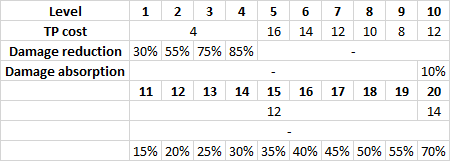
At levels 1-4, reduces the damage of one instance of Fire/Ice/Volt damage to each party member. At levels 5-9, nullifies one instance of Fire/Ice/Volt damage to one party member. At levels 10-20, absorbs one instance of Fire/Ice/Volt damage to one party member, healing the target for a percentage of the original damage.
Despite the heavy nerfs that the Walls ate in EOU, they're still absolutely vital skills that you'll want leveled up to at least 5 by some point. There are a LOT of bosses that have all-party elemental attacks that will kill less-than-durable classes and leave everyone else severely hurt.
Heal Guard
Type: Guard and healing skill
Max level (innate): 10
Requirements: Shield Mastery level 5
Required equipment: Shield
Body parts used: Arms
Stats used: TEC, VIT

Restores one party member's HP, and reduces all physical damage to that party member for one turn.
Much like Keep Guard, I don't entirely get why this skill exists. Also much like Heal Guard, I guess it has some use with a Beast. The question of "why are you stacking a Beast and Protector in the same party" still remains.
Shield Smite
Type: Attack skill, attempts to bind arms
Max level (innate): 10
Requirements: Shield Mastery level 7
Required equipment: Shield
Body parts used: Arms
Stats used: STR, VIT, LUC

Deals melee Bash damage to one enemy. Attempts to bind the target's arms. Shield Smite uses the average of the user's STR and VIT as a replacement for STR in the normal damage formula, and considers the user's shield to be their weapon, with the DEF value being multiplied by a certain amount to replace ATK. Has a 200% speed modifier at all levels.
In theory, Shield Smite is useful for when your Protector doesn't have a shield skill they need to use for one turn. In practice, your Protector is most likely going to have their hands full at all times, rendering Shield Smite impractical at best and actively detrimental to your survival at worst.
Shield Rush
Type: Attack skill, lowers physical damage
Max level (innate): 10
Requirements: Shield Smite level 5
Required equipment: Shield
Body parts used: Arms
Stats used: STR, VIT

Deals melee Bash damage to all enemies. Lowers hit targets' physical attack for a certain amount of turns. Shield Rush uses the average of the user's STR and VIT as a replacement for STR in the normal damage formula, and considers the user's shield to be their weapon, with the DEF value being multiplied by a certain amount to replace ATK. Has a 150% speed modifier at all levels.
See my opinion on Shield Smite above.
Sentinel Guard
Type: Guard skill
Max level (innate): 10
Requirements: Shield Mastery level 10
Required equipment: Shield
Body parts used: Arms
Stats used: VIT

Reduces all damage to the party for one turn. Also sets each party member's defense values (VIT, DEF, etc.) to the user's for one turn. Disables the user's shield skills for one turn after use.
Sentinel Guard is a situational but still very good skill. The flat damage reduction is already nice, but the defensive-stat-setting makes it even better. As for the "disables shield skills" downside, what that means is Sentinel Guard is best used when you know an enemy is about to use a very hard-hitting attack, and you are confident the party can weather the storm on the turn after. Alternatively, you can just use Perfect Defense on the turn after Sentinel Guard, since that doesn't count as a shield skill.
Provoke
Type: Provoke
Max level (innate): 10
Requirements: Phys DEF Up level 1
Body parts used: Head
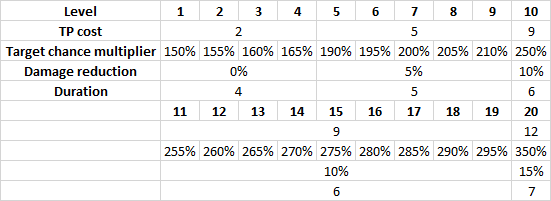
Places a buff on the user that increases the chance of enemies targeting them, as well as increasing the user's physical defense, for a set amount of turns. Has a 500% speed modifier at all levels.
Provoke's been a staple of the Protector skillset for pretty much all of the series--even Fortresses in EO4 had it. It's useful for random encounters, but very situational for boss fights. My issue with Provoke is that having to cast/re-cast it means your Protector isn't using a shield skill for one turn, which can potentially lead to bad things (to say the least).
Pre-Provoke
Type: Passive
Max level (innate): 5
Requirements: Provoke level 5

If the user knows Provoke, passively gives them a chance to use it immediately upon starting a battle.
If you really insist on using Provoke, Pre-Provoke is a decent little passive. There's not a lot else to be said about it.
Fortify
Type: Physical defense buff
Max level (innate): 10
Requirements: Phys DEF Up level 3
Body parts used: Arms
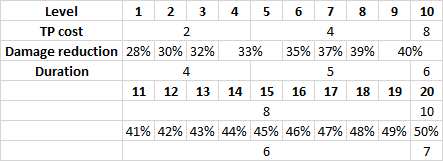
Places a buff on the user that reduces the amount of physical damage they take for a set amount of turns. Has a 200% speed modifier at all levels.
I don't really like Fortify. On one hand, it's a pretty fantastic defensive buff. On the other hand, it means your Protector isn't, y'know, protecting the rest of the party for one turn.
Parry
Type: Passive
Max level (innate): 5
Requirements: Phys DEF Up level 5

Passively gives the user and all allies in their row a chance to nullify physical damage.
A very, very nice passive. The chance might not seem high, but any passive reduction to damage is useful, especially when it can apply to other party members.
Line Cure
Type: Healing skill
Max level (innate): 10
Requirements: Elem DEF Up level 3
Body parts used: Head
Stats used: TEC, VIT

Restore one row's HP.
Y'know how I've been down on skills that aren't shield skills? Yeah, this applies to Line Cure too.
Line Heal
Type: Healing skill
Max level (innate): 10
Requirements: Line Cure level 5
Body parts used: Head
Stats used: TEC, VIT

Restore one row's HP. Has an 80% speed modifier at all levels.
See above.
Aegis
Type: Passive
Max level (innate): 10
Requirements: Elem DEF Up level 5

Passively gives the user a chance to survive a mortal hit at 1 HP. Cannot be stacked with Deadly Resoolve.
Aegis is a nice passive, even if your Protector probably isn't going to be the brunt of attacks most of the time. If you're running Provoke, Aegis can seriously increase your Protector's survivability.
Armor of Light
Type: Protecting buff
Max level (innate): 10
Requirements: Elem DEF Up level 10
Body parts used: Head
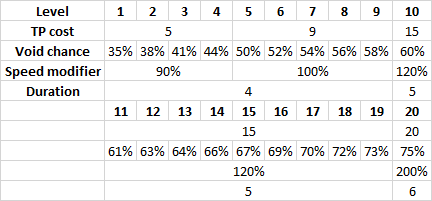
Places a buff on the user that gives them a chance to nullify ailments, binds, and debuffs directed at them for a set number of turns.
Armor of Light is an amazingly good buff, but much like every other skill that isn't a shield skill, using it means your Protector isn't guarding the rest of the party.
Shield Protect
Type: Force Boost
If an ally is under the effect of a shield skill, the damage they take after the effect of the shield skill is halved.
One of the most useless Force Boosts. Shield skills are already going to reduce damage heavily, an extra halving isn't going to do much.
Perfect Defense
Type: Force Break
Body parts used: Arms
Completely nullifies all damage to the party for one turn. Also nullifies any extra effects on damaging skills, such as ailments and binds. Does not do anything against skills that exclusively try to inflict stuff.
On the flipside, one of the most useful Force Breaks. Perfect Defense has a lot of applications: completely stopping an enemy turn that would've killed your party, giving you a free turn to get your party back on its feet when you're severely hurting, protecting your party after Sentinel Guard, etc.